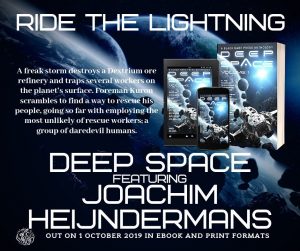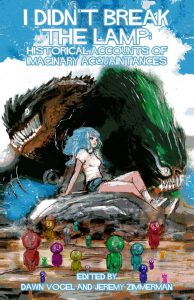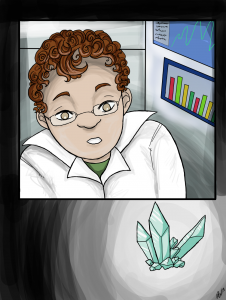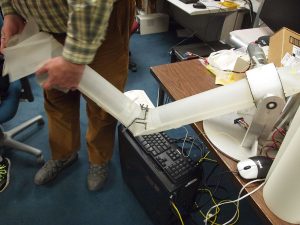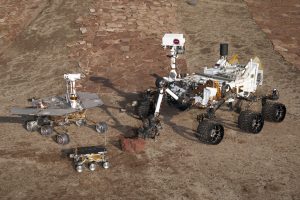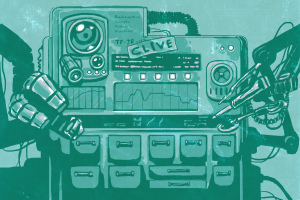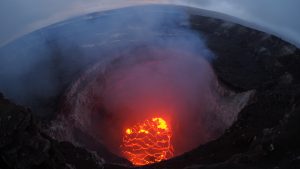Today is our final interview with our I Didn’t Break the Lamp authors. This final interview is with the author who has the first story in the anthology, Sam Crane!
DV: Tell us a bit about yourself!
Sam Crane: The general consensus is that I’m unusually optimistic and cheerful for a human. I love writing, and I’ve been working at it in some form since I was a child. Nowadays I write mostly sci-fi, some fantasy, and light horror. When I’m not writing, I work in the tech industry. I’m also a huge nerd–board games, RPGs, and anime conventions are my jam. Oh, and I play the Pokémon trading card game competitively. Basically, I’m an oddball, but I have a lot of fun!
Currently, I’m lurking around the web on Blogspot or Goodreads: http://sam-crane-writes.blogspot.com or http://www.goodreads.com/author/show/18937595.Sam_Crane
DV: What inspired you to write “The Last Cory” for I Didn’t Break the Lamp?
SC: When I first read the submissions call, I spent a couple weeks with it in the back of mind just mulling it over. At first I thought I might do a ghost story, but that idea slowly morphed into the current story. I’m a big fan of curses as plot devices, so I thought it would be interesting to have something like that. The scene where Josephine Cory meets her imaginary companion was actually my starting point and sprang into my mind pretty much as it is in the final version of the story, and then the rest of the details fell into place as I worked through the various drafts.
DV: You mention in your bio that New England is one of your influences. How did an area with such a long history play into this story in particular?
SC: I’ve read a number of New England folktales and short stories where there’s this sense that devils/the Devil are just a matter of fact. Like “yeah Thompson got waylaid by the Devil up on that hill outside town, third time this month.” I’m being slightly facetious, but still. There’s this sense that all of these supernatural occurrences are real and even normal to a point.
I wanted to create a similar kind of feeling but in a more modern setting. In “The Last Cory,” people are like “oh of course the Cory farm is haunted, bedeviled something fierce.” The town gossips about it–it’s part of the local color and superstition, but at the same time, no one’s seen anything in decades, and they don’t really believe it. It’s weirdly isolating for Josephine to have people going around saying her farm is haunted, but if she were to go on about it, they would say she’s mad.
DV: Without giving away too much of your story, how would you characterize the “imaginary” acquaintance in your story? Is she more real than imaginary? Is she more friend than foe?
SC: She’s definitely some kind of real. As for her intentions … let’s say she’s determined to carry out justice. Or vengeance, depending on your perspective.
DV: If you had an imaginary friend growing up, what was their name, and what were they like?
SC: I kind of had several. When I was little, I would pretend Ginger from Black Beauty was my friend and followed me around, like to school. My best friend at the time joined in too except her imaginary friend was Black Beauty.
I also was/am a big fan of the Animorph series, and this became my go-to imaginary world when I was a little older. I would pretend I was an Animorph and getting communications from the Andalite navy or spying on possible Yeerks. I was very into it!
DV: What’s on the horizon for you?
SC: I do have about half a dozen other short stories submitted, and I’m waiting to hear back about them. Besides one superhero shenanigans story, this current crop is more dark fantasy/light horror. I’d say it’s similar in tone to “The Last Cory”–maybe even a bit darker. On the WIP pile, I have more superhero and sci-fi ideas to flesh out.
Besides short stories, I’m also working on a YA fantasy novel tentatively titled The Rabbit God. It’s about a young boy, James, befriending Rabbit, the last remaining guardian animal of a forest that’s been clear-cut. The novel will focus mainly on their friendship and how they help each other grow as people.
Thanks to our authors for participating in these interviews! We hope you’ll enjoy their stories in I Didn’t Break the Lamp, which will be out on Tuesday, October 15th!


